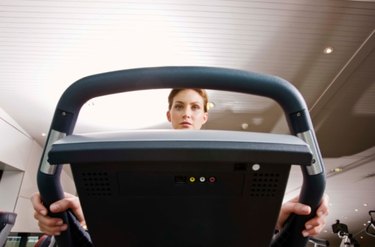
After knee surgery, you may be impatient to return to your former activities. Your recovery will require patience and time, however, and you should not rush into an activity that could damage your knees or hinder your recovery. Treadmill exercise is one activity that you can begin early in your recovery, provided you follow your therapist's advice and take advantage of the recovery technologies available to you.
How a Treadmill Compares to Other Exercise
Video of the Day
Many exercises can help you recover from knee surgery, and using a treadmill is among the better ones. Researchers at Scripps Clinic in La Jolla, California, ranked several exercises by the amount of force they put on your knees after a total knee replacement. Using a treadmill produces approximately 2.05 times the force of your body weight. Only biking, which produces 1.3 times your body weight, was found to be less stressful to your knees. Walking on a treadmill was found to produce slightly less force than walking on level ground, and much less force than more athletic activities like tennis, golf or jogging.
Video of the Day
How Long to Wait After Surgery
The University of Wisconsin School of Medicine and Public Health recommends engaging in light, therapeutic exercise as early as three to four days after your surgery. This could include low-impact exercise on a stationary bicycle at first and, when you're ready, you can move on to the treadmill. Three to seven days after your surgery, you should be ready for a more organized recovery regimen which includes treadmill use. If you are used to a rigorous workout on a treadmill, you may wait up to six weeks before you return to your previous pace.
The Benefits of a Treadmill After Knee Surgery and Knee Replacement
Continuing to use the muscles and ligaments around your knee will promote a fast recovery. Treadmills are a common part of rehabilitation and therapy after surgery because of their minimal impact on your healing knee. The use of an electronic treadmill also allows you or your therapist to set a consistent pace and to track your progress more precisely. A treadmill's rails allow you to shift support of some body weight to your arms, taking pressure off a delicate knee after surgery. As you progress, the treadmill can be reprogrammed to simulate a faster pace or greater distance. You can also make less use of your arms as you grow more comfortable with putting weight on your knee.
Alternative Treadmill Applications
In some instances, even the low-impact workout you get from a treadmill may be too intense during your early days of therapy. Underwater treadmills further reduce the pressure on your knees by submerging you and relying on your body's buoyancy to help lift you. The water provides some additional resistance against your body's surface area, which allows you to exercise against resistance without putting pressure from your body's weight on the knee.
Another alternative treadmill design in use at the Indiana Orthopaedic Hospital simulates a low-gravity environment to reduce strain on the knee. When a patient stands in the device, it calibrates itself according to the patient's weight and pressurizes the air within to diminish the pressure on that patient's knee. A 120-lb. patient using this treadmill would feel like he weighs 108 lbs. while the device is active.
- Palo Alto Medical Foundation: Knee Rehabilitation Exercises; Warren D. King; 2010
- Hips For You: Underwater Treadmill Exercise to Strengthen Muscles, Hip-Abduction Strength and Gait Strength; Atanu Ghosh; July 2, 2009
- Bay Area Medical Information: Study Identifies the Best Type of Exercise That Generates the Least Force on the Knee; N Thompson; April 2008
- Indy.com: Hospital Says Anti-Gravity Treadmill Speeds Recovery; Shari Rudavsky; Oct. 5, 2010
- University of Wisconsin School of Medicine and Public Health: Arthroscopic Knee Surgery Home Exercise Program; June 23, 2010